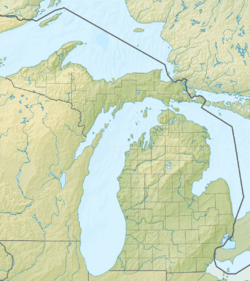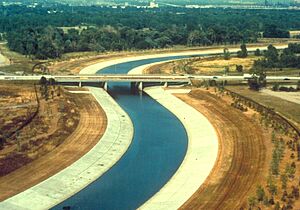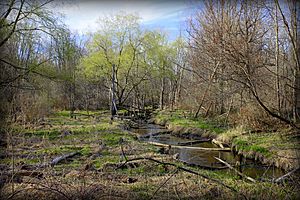River Rouge (Michigan) facts for kids
Quick facts for kids River Rouge |
|
|---|---|

Man-made falls on the River Rouge at Henry Ford's Fair Lane estate.
|
|
|
Location within the state of Michigan
|
|
| Other name(s) | Rivière Rouge |
| Physical characteristics | |
| Main source | Rochester Hills, Oakland County, Michigan 42°37′56″N 83°10′35″W / 42.63225°N 83.17632°W |
| River mouth | Detroit River, Michigan 42°17′17″N 83°06′10″W / 42.28809°N 83.1027°W |
| Length | 127 mi (204 km) |
| Basin features | |
| Basin size | 467 sq mi (1,210 km2) |
The River Rouge is a 127-mile (204 kilometer) river in the Metro Detroit area of southeastern Michigan. It flows into the Detroit River near Zug Island, which is between the cities of River Rouge and Detroit.
The river's watershed covers about 467 square miles (1,210 square kilometers). This area includes parts of 48 towns and cities. More than 1.35 million people live in this watershed.
Most of the land around the river is urban and suburban. This means there are many homes and factories. Even so, over 50 miles (80 kilometers) of the River Rouge flow through public lands. This makes it one of the easiest rivers to visit in Michigan.
For a long time, the River Rouge was very polluted. In 1969, oil on the river even caught fire! After that, the Clean Water Act was passed in 1972. This law made it illegal to dump pollution directly into rivers.
In 1986, a group called Friends of the Rouge started. They began an annual cleanup event called Rouge Rescue. This helped people learn about the need to clean up the river. In 1987, the entire river area was named a Great Lakes "area of concern." This meant it needed special attention for cleanup.
Big cleanup projects started in 1992. Today, groups like the Alliance of Rouge Communities continue to work on keeping the river healthy.
Contents
What Is the River Rouge Like?
The River Rouge is 127 miles (204 kilometers) long. It has four main parts: the main branch, the upper branch, the middle branch, and the lower branch. These branches come together as the river flows towards the Detroit River.
The last 1.5 miles (2.4 kilometers) of the river were made wider and deeper. This allowed large ships to reach Henry Ford's River Rouge Plant. This huge factory was built between 1915 and 1927. It was special because it made almost everything needed for cars right there. This included steel, glass, and even its own power. At one point, 100,000 people worked there! The plant is now a National Historic Landmark.
Where Does the Main Branch Flow?
The main branch starts in Rochester Hills and Bloomfield Township. It flows south through many cities like Troy, Birmingham, and Southfield. Then it goes through western Detroit and Dearborn Heights. Finally, it turns southeast through Dearborn and other towns before reaching the Detroit River.
Some smaller streams that join the main branch include:
- Franklin River
- Pebble Creek
- Evan's Creek
- Upper Branch
- Middle Branch
- Lower Branch
- Ruby Creek
Where Do the Other Branches Flow?
The upper branch starts in West Bloomfield Township and Commerce Township. It flows southeast through Farmington Hills, Livonia, and Redford Township. It joins the main branch in northwest Detroit.
The middle branch starts near Northville. It flows south through Northville Township and Plymouth Township. Then it turns southeast through Plymouth, Livonia, Westland, and Garden City. It joins the main branch in Dearborn Heights.
The lower branch starts in Superior Township in Washtenaw County. It flows east through Canton Township, Wayne, Westland, Inkster, Dearborn Heights, and Dearborn. It then joins the main branch.
Why Is the River Rouge an "Area of Concern"?
The Great Lakes Water Quality Agreement is a plan between the U.S. and Canada. It calls certain places "Areas of Concern" (AOCs). These are places where human activities have caused a lot of harm to the environment. The River Rouge is one of these AOCs.
Pollution in the River Rouge
More than half of the land around the River Rouge is used for homes, factories, and businesses. This means a lot of pollution can enter the river. Because of this, the River Rouge was named a Great Lakes Area of Concern in 1987. The AOC covers the entire watershed, which is 466 square miles (1,207 square kilometers) across 48 communities.
Pollution comes from many places. This includes waste from factories and cities, and water that overflows from sewers. Rainwater runoff from streets and yards also carries pollution. These activities have put harmful chemicals into the river's water and mud. These chemicals include PCBs, heavy metals like mercury, and oil. These are bad for fish, wildlife, and for people who want to use the river for fun.
In 2008, a plan was made to fix the problems. It listed nine main issues caused by the pollution:
- Unsafe Fish and Wildlife: It's not safe to eat fish or wildlife from the river because of harmful chemicals.
- Too Much Algae: Too many nutrients from farms and factories cause too much algae to grow. This is called Eutrophication.
- Fewer Fish and Wildlife: The number of fish and animals in the river has gone down.
- Closed Beaches: Beaches are sometimes closed because the water might make people sick.
- Sick Fish: Fish can have tumors or other problems because of the chemicals.
- Ugly River: The river doesn't look or smell good.
- Harm to River Bottom Life: Small creatures that live at the bottom of the river, called benthos, are harmed. These creatures are important for the food chain.
- Dredging Problems: It's hard to dig out the river bottom (dredge) because the mud is so polluted.
- Lost Homes for Animals: Fish and wildlife have lost their natural places to live.
Fun Things to Do at the River Rouge
Even with its past pollution, the River Rouge offers many places for outdoor fun.
Eliza Howell Park
Eliza Howell Park is a large park covering 250 acres (101 hectares). Part of it was given to the city in 1936.
Fair Lane Estate
Henry Ford built his home, Fair Lane, on the river in Dearborn. This was upstream from his factory. Today, it's on the campus of the University of Michigan–Dearborn. The estate is a National Historic Landmark. You can visit the home, which is now a museum. The gardens were designed by a famous landscape architect, Jens Jensen.
The Henry Ford and Greenfield Village
The Henry Ford is a very popular place to visit. It includes Greenfield Village. Greenfield Village opened in 1929 to save important historic buildings. You can see things like Noah Webster’s house and Thomas Edison’s lab. You can also see the garage where Henry Ford built his first car, the Ford Quadricycle.
Rouge River Bird Observatory
Since 1992, the Rouge River Bird Observatory has been on the University of Michigan–Dearborn campus. Here, scientists study birds that live near the river.
Rouge River Gateway Greenway Trail
This trail lets you walk or bike along the river. You can get on the trail from Michigan Avenue in Dearborn, from Fair Lane, and from the University of Michigan–Dearborn campus. There are plans to make the trail go all the way to the Detroit River.
River Rouge Park
River Rouge Park is in Detroit and has been open since the 1920s. It is the largest park in Detroit, covering 1,184 acres (479 hectares). In 2014, two large swimming pools and a bathhouse were reopened there. This park is even bigger than the well-known Belle Isle State Park in Detroit.
Other Parks and Recreation Areas
- Lower Rouge Parkway
- Middle Rouge Parkway
- Douglas Evans Nature Preserve






